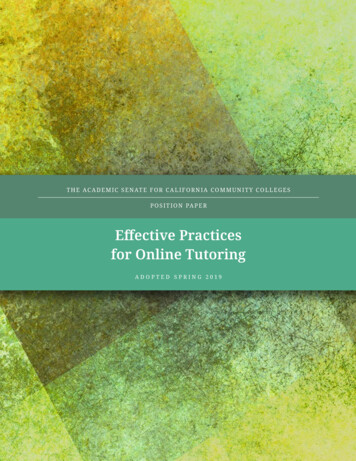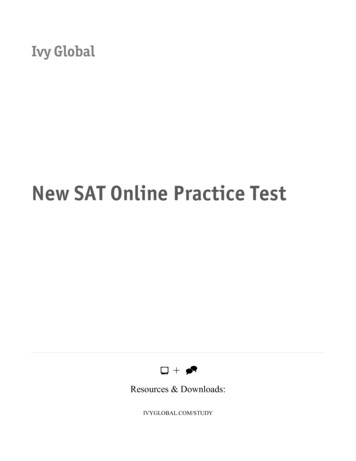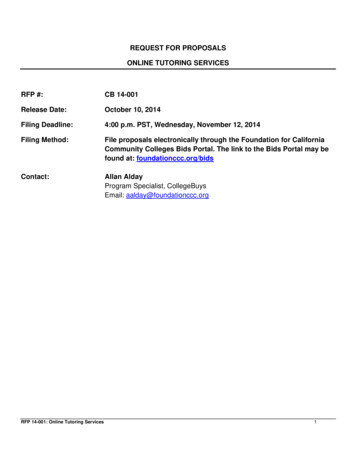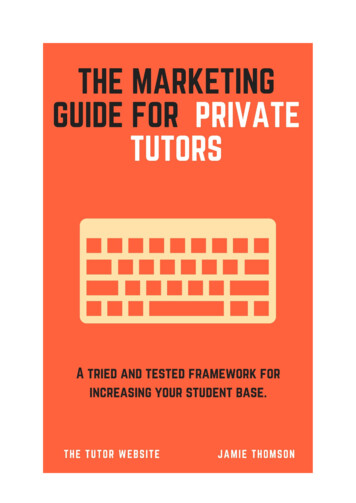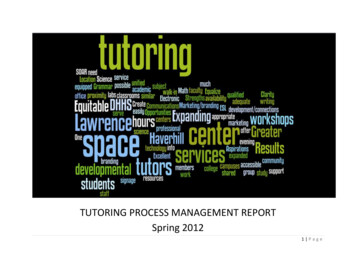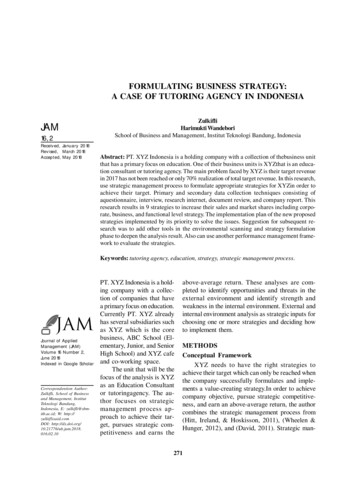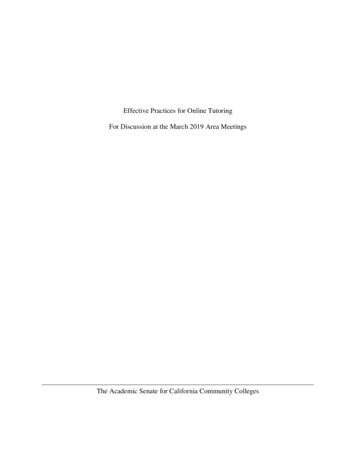
Transcription
Effective Practices for Online TutoringFor Discussion at the March 2019 Area MeetingsThe Academic Senate for California Community Colleges
Effective Practices for Online Tutoring 1The Transfer, Articulation, and Student Services Committee 2018-2019Committee MembersMichelle Velasquez Bean, Chair, Rio Hondo CollegeArthur Guaracha, Southwestern CollegeGraciela Sae-Kleriga, Southwestern CollegeKaren Chow, De Anza CollegeLaTonya Parker, Moreno Valley CollegeLynn Fowler, American River CollegeTanya McGinnis, Antelope Valley CollegeTeresa Aldredge, Cosumnes River College
Effective Practices for Online Tutoring 2Table of Contents[Page numbers to be added in final document.]IntroductionHow To Use This PaperJustification for the PaperAccreditation and Online TutoringThe Value and Benefits of Online TutoringAudiences for Online TutoringOnline Tutoring Skills and PracticesOnline Tutoring Interfaces and ResourcesNetTutor ServicesLocal ServicesOnline Tutoring Center versus Online ResourcesVideo Conferencing and Campus ServicesThe Role of the CoordinatorPreparing the TuteeTraining and Ongoing Professional Development for In-House TutorsScaffolding, Digital Badges, VideosChallenges and Parameters of ServicesChallenges to Effective Online TutoringInstitutional ChallengesTutor ChallengesTutee ChallengesParameters of Use of ServicesConfidentialityPlagiarismLog-In Systems and Use of ServicesDrop-Ins, No Shows, and CancellationsAmericans with Disabilities Act (ADA) ComplianceConclusionRecommendations for PracticeReferencesAppendices
Effective Practices for Online Tutoring 3IntroductionAs institutions of higher education seek to support students through innovative learning andteaching methods, many colleges have begun to investigate the opportunity to provide tutoringthrough distance education formats. Student success support is not limited to face-to-faceinteractions within the classroom. As awareness of online tutoring and its role in supportingcommunity college students increases, many colleges have set goals to eliminate barriers inproviding student success support by implementing effective practices for online tutoringprograms.Shifting demographics within the state of California and more specifically within the CaliforniaCommunity College (CCC) system has created a need for equitable solutions for the success ofour students. Students who enter our institutions should be afforded the same level of supportwhether they enter virtually or in-person. The development of the Online Education Initiative(OEI) has sparked great interest and collaboration within the system to support students’successful completion of courses by using online support services such as online tutoring. Thevalue of framing the need to innovate and reimagine the way we serve students in a continuallyadapting and evolving world of technology is equally important. We must meet the needs of allstudents who may have barriers to success, such as full workloads along with coursecommitments and other barriers impacting our diverse student populations. This paper examinesmultiple resources available for the development and use of online tutoring support.How To Use This PaperThis document was created by the Academic Senate for California Community Colleges’(ASCCC) Transfer, Articulation, and Student Services Committee (TASSC) intended foracademic senates to use as a guide for online tutoring considerations. It may also be used toassist community colleges with the development of effective practices for online tutoringprograms. Information described in this paper may help to develop, enhance, and identify areasof both value and concern for online tutoring programs. As such, this paper contains multiplesections that include the following: 1) Accreditation and Online Tutoring, 2) The Value andBenefits of Online Tutoring, 3) Audiences for Online Tutoring, 4) Online Tutoring Skills andPractices, 5) Challenges and Parameters of Services, and 6) Recommendations for Practice.Justification for the PaperDuring the spring 2008 plenary session of ASCCC, the delegates representing the Californiacommunity colleges passed the following resolution:Resolution 13.04 Spring 2008 – Effective Practices for Online TutoringWhereas, Distance education has become a significant portion of California communitycollege offerings, and parallel and equivalent services need to be offered to all students;Whereas, Online academic tutoring services for distance education students are beingimplemented across the state as online programs expand; and
Effective Practices for Online Tutoring 4Whereas, Tutoring services are an effective means of supporting students, and faculty areconcerned with student success and academic quality;Resolved, That the Academic Senate for California Community Colleges research andprepare a paper that addresses effective and non-effective practices for establishing onlinetutoring programs.Following the resolution, the Online Education Initiative (OEI) workgroup began investigatingonline tutoring platforms and piloting effective practices in conducting online tutoring. In fall of2012, the Counseling Library Faculty Issues Committee published the Rostrum article“Successful Online Tutoring Part I: Getting Started,” which briefly discussed interest, need, andinitial implementation strategies for colleges seeking to build online tutoring programs (Smith,2012).In fall of 2018, the charge of writing a paper fully addressing the changes, challenges, benefits,and effective practices of online tutoring was assigned to the members of TASSC. In response tothe changing needs of distance education and the challenges of meeting the needs of our diversestudent population, TASSC has also consulted with leaders in the field. The Association ofColleges for Tutoring and Learning Assistance (ACTLA) is developing a set of recommendedcriteria for online tutoring at the time of this paper’s publication. 1 ACTLA’s recommendationsonce published may be used to support this paper in assisting colleges and local senates seekingto build programs, procedures, and effective practices for online tutoring.Accreditation and Online TutoringInstitutional effectiveness is driven by a campus-wide effort to meet the needs of students viaaccreditation standards, and the growing interest in developing online tutoring programs couldbe an additional and viable campus resource for student success programs seeking to meetaccreditation standards. According to the Accrediting Commission for Community and JuniorColleges (ACCJC), accredited institutions are most successful when curriculum, programs, andservices foster student learning and achievement via data-informed program design,implementation, and assessment. There are two types of accreditation: institutional (evaluationof overall campus) and programmatic (evaluation of programs, courses of study, etc.). Both areimportant, as programmatic goals support institutional goals; thus, the development of aneffective online tutoring program could certainly support a college’s institutional goals. TheACCJC requires four standards as a framework to promote student success (2014): Standard I: Mission, Academic Quality and Institutional Effectiveness, and IntegrityStandard II: Student Learning Programs and Support ServicesStandard III: ResourcesStandard IV: Leadership and GovernanceThe following paragraph highlights examples that an online tutoring program could satisfy forthe aforementioned standards:1For more information and documents, see ACTLA’s website at http://actla.info/.
Effective Practices for Online Tutoring 5An effective online tutoring program’s goals and outcomes should be aligned with the overallmission of the institution to ensure high-quality programming, evidence of student learning, andintentional use of resources (Standard I.A.1, Standard I.B.7). They should be designed usingshort- and long-term goals, learning outcomes, and a continuous assessment of services touphold institutional effectiveness. This will lead to a highly successful comprehensive programreview focused on student development and achievement. For example, colleges that can collectstudent demographic data (i.e., gender, age, major, course, enrollment status, units completed,degree goal, grade point average, etc.) and affective outcomes detailing students’ feelings andattitudes of services (e.g., availability of tutors, program hours, validation, technology, etc.) havea greater likelihood of creating programs that meet their students’ individual needs.To support instructional programs and student learning, it is recommended that online tutoringservices meet the needs of students via equitable access to tutoring and a continuous assessmentof student progress, learning, and success, regardless of service location and delivery method(Standard II.A.7, Standard II.B.1). Moreover, in designing effective online tutoring programs,students should be viewed from an asset-based learning lens, which recognizes the skills andstrengths of students. Further, this framework seeks to empower students by helping themunderstand and apply the knowledge and experience they bring to the learning session. Thisconcept can help increase students’ confidence and critical thinking, which promotes studentsviewing themselves as leaders and teachers in a transaction of learning, rather than merelylearning content through a transmission of information (Metz and Bezuidenhout, 2017; Peacockand Cowan, 2016).Human, physical, technology, and financial support are needed to ensure program success.Colleges must invest in training and technology that provides the greatest opportunity forsuccessful development and implementation of services (Standard III.C.4, Standard III.D.16).When a college considers developing learning support services, it is incumbent on the college toensure those resources are accessible and well-maintained, and are regularly evaluated for theireffectiveness (Standard I.B.4). This should include developing resources for the program andstudents alike. For example, colleges can purchase software or use online platforms that supportthe short- and long-term goals of the online tutoring program. Additionally, colleges canproactively remove barriers that may prevent students from accessing the services. This equitydriven practice includes ensuring students have reliable wireless internet on campus andaccessible computer labs with any necessary equipment for an online tutoring session, oropportunities to rent or purchase discounted tablets or electronic devices.The hiring, development, and support of qualified personnel is also needed to create an effectiveonline program. Tutors must be well-versed in the use of technology, subject matter, and tutoringstrategies, such as building a welcoming and engaging online environment for students (Metzand Bezuidenhout, 2017). Periodic evaluations and training for personnel are important toensuring the quality and standards of service. These standards and professional developmentopportunities must be aligned with the overall goals of the program and of the institution. Moreon training and professional development for tutors will be described later in this paper.
Effective Practices for Online Tutoring 6Supportive leadership is key for programming success (Standard IV.A.1). Campus leaders (i.e.,boards of trustees, presidents/superintendents, vice presidents, deans, and faculty leaders) shouldbe well informed of the tutoring program’s goals, challenges, and achievements, as theseindividuals have access to financial, technological, physical/facilities, and social/networkingresources that can aid in the advancement and continuation of tutoring services for students.The Value and Benefits of Online TutoringOnline tutoring provides benefits for all students, as well as for the institution and the faculty. Aspreviously mentioned, effective online tutoring creates supplemental opportunities for studentsenrolled in all types of courses: face-to-face, hybrid, and online. These programs are an essentialresource for community college students who largely commute to campus and have externalfactors that compete for their time.Online environments for completion of courses, degrees, counseling, and tutoring are becomingmore prevalent in higher education. The number of students taking online courses has increaseddramatically in recent years. In fact, a U.S. News article reported that federal data from a studyconducted by Babson Survey Research Group of more than 4,700 colleges and universities,found that more than 6.3 million students in the United States took at least one online course infall 2016, a 5.6 percent increase from the previous year (Friedman, 2018). The article also statesthat this is the fourteenth consecutive year of reported growth in online enrollment. Similarly,distance education has nearly tripled in the California Community Colleges over the last 12years. For example, a total of 860,283 unduplicated students enrolled in a distance educationcourse during the 2016-2017 academic year compared to 328,372 during the 2005-2006 year(CCCCO, 2017). To support these students, colleges have increased their online services toinclude advising, counselling, and tutoring. A recent Community College Success Network(2015) tutor center survey found that 47 colleges offered tutoring through a learning center(83%), followed by online platforms (56%) or computer labs (56%), in comparison to the use oftraditional classrooms (40%), multipurpose space (28%), or the library (15%). Because of thisgrowing trend, learning centers have found it essential to incorporate technology and other onlineresources to adapt and meet the needs of students. Online tutoring allows students who haveobstacles or barriers to receiving in-person campus assistance the equitable opportunity forsuccess services beyond the boundaries of the physical campus space.Online tutoring proactively creates opportunities to engage students in their communities using amyriad of access modalities (e.g., via phone, e-mail, or computer/video conferencing platforms).Similar to face-to-face learning assistance programs, online tutoring can help students enrolled inmultiple courses from various disciplines. Online tutoring programs may assist students withvarious needs for course success, such as the development of ideas, organization of information,formatting of research papers, and preparation for exams, to name just a few activities. Toachieve success in these areas, online experiences for tutors and students must be equivalent toface-to-face tutoring services. Tutor and student expectations for a successful learning sessionwill be addressed later in this paper.Audiences for Online Tutoring
Effective Practices for Online Tutoring 7The California Community College (CCC) system serves 2.4 million students at 114 communitycolleges. Many of these students commute to campus, work off-campus in part-time or full-timesituations, and may have family or individual responsibilities that can often create barriers tosuccess. These factors compete for students’ time and can impact their enrollment decisions,their use of campus services, and their ability to succeed. To positively support students, manycolleges have created various methods of course delivery, including traditional face-to-faceclassrooms, where students attend lectures in-person; hybrid or blended classrooms, where aspecified number of course hours include online learning in addition to face-to-face attendance;and finally, online courses, where students do not meet in a physical classroom so that learningcan be accessed anytime within any space. Online tutoring can be a flexible resource designed tosupport students within all of these course delivery methods.As noted in our Rostrum article “Successful Online Tutoring,” “The goal of online tutoring is tocreate a virtual tutoring environment for students that emulates a face-to-face experience whichcan help a student achieve success in a given class” (Smith, 2012). As such, online tutoring wasdesigned to meet the needs of all community college students and these services are especiallyuseful for the large numbers of community college commuter students and students withchallenges or disabilities who are limited in their ability to physically access on-campusacademic tutoring support. Therefore, online tutoring programs are responsive to the needs of allcommunity college students, and they create authentic opportunities for students to engage insupport services outside of the physical space of the college campus.Online Tutoring Skills and PracticesEffective skills and practices for both the tutor and the tutee2 are critical in the success of anonline tutoring program. The necessary skills and practices may vary depending on the college’sneeds and available resources, the type of platform or interface used, and the subject(s) beingtutored. In this next section of the paper, descriptions of some basic roles, competencies,practices, and resources suggested for online tutoring will be given.Online Tutoring Interfaces and ResourcesColleges have two major options for online tutoring interfaces and resources: 1) contractingtutoring services through proprietary online tutoring companies (such as NetTutor) and 2)training in-house tutors and making their services available using a technology platform (such asWorldWideWhiteboard or any other online conferencing platform).When colleges consider or engage in requests for services from proprietary companies fortutoring interfaces, platforms, and resources, they are encouraged to research various elements ofthe services provided, such as the following: cost, content/subjects tutored, functions oravailability of technology (e.g., chat, instant messaging, video, interactive whiteboards, file2The term “tutee” is used by experts in the field of tutoring and learning centers, as synonymous with “the student”who uses tutoring services.
Effective Practices for Online Tutoring 8sharing, cell phone capability, etc.), customer ratings, tutor qualifications, available hours anddays, synchronous or asynchronous 3 options, and ease or user-friendliness.Additionally, colleges in the development stage of an online program may need to investigate theavailable campus resources and existing learning or tutoring centers to assess the most effectivemeans of providing online tutoring services for the campus. The following paragraphs provide anoverview of the key components of proprietary companies, specifically NetTutor, along with anoverview of the use of local or in-house tutors for comparison.NetTutor ServiceCurrently, through the CCCCO California Virtual Campus - Online Education Initiative (CVCOEI),4 California community colleges in the CVC-OEI consortium have access to a freesystemwide license for the use of WorldWideWhiteboard, as well as access to reduced-costlicenses for the use of NetTutor. The CVC-OEI isa collaborative effort among California community colleges to ensure that significantlymore students are able to complete their educational goals by increasing both access andsuccess in high-quality online courses. . . . Composed of high-quality online courses,resources for students, and technology, the CVC-OEI represents a comprehensive andcollaborative program that leverages effective practices and technology to significantlyincrease the opportunity for higher education degree attainment in California. (“AboutOEI,” n.d. )NetTutor, the tutoring service currently available to CVC-OEI consortium colleges, is an onlinetutoring service provided by a company called Link Systems International (LSI). LSI selects andtrains the tutors and delivers tutoring services through the WorldWideWhiteboard platform.NetTutor can be integrated with Canvas, a widely-used course management system among theCCC system; this integration enables students to have a single sign-on access to NetTutor, whichmeans
Karen Chow, De Anza College LaTonya Parker, Moreno Valley College Lynn Fowler, American River College . Resolution 13.04 Spring 2008 – Effective Practices for Online Tutoring Whereas, Distance education has become a significant portion of California community college offerings, and paral
